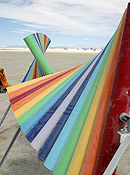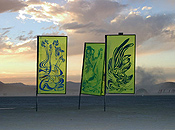Our art theme in 2004, The Vault of Heaven, explored the universe and its physical contents, focusing on astronomy and physics. The stars, constellations, planets, quasars, black holes, spaceships, telescopes, aliens, astronauts and space exploration were some of the subjects seen in the theme art installations.
The Man stood atop an Observatory in the form of a geodesic dome resting on a round base embellished with classical columns. The interior of the dome served as a gallery housing ten interactive installations, as well as Tim Black’s installation Optical Acoustics. The ground floor exterior contained ten small stages, each defined by a diorama, designed by ten different participants. We asked participants to claim one of the stages and direct interactive theater, which created an easy way join in supporting the theme. We found, however, that people would rather perform their own fantasies and ideas, as in the niches at the temple in 2003, than follow someone else’s scheme. Some off-planet theater did occur, but the stages didn’t seem to attract as much enthusiasm as did the temple niches the previous year.
 The Vault of Heaven theme divided the playa into two worlds. The Solar System was the area radiating from the Man to the city and to the 12:00 point above the Man, where David Best’s temples have stood in past years. Beyond this point, Deep Space extended to the perimeter fence. David Best’s Temple of Stars was moved back to a point on the 12:00 meridian about halfway between the 12:00 spot and the fence. As always, we placed theme art installations along the four walkways extending from the Man to 12:00, 3:00, 6:00 and 9:00. Others were arrayed along the esplanade and in Deep Space. The keyhole location at the top of Center Camp was occupied by a gigantic Foucault’s pendulum, Cosmic Dance by D.J. Dunkle. Unfortunately, several of the theme art projects mapped on the 6:00 walkway were moved out to Deep Space at the request of the artists, so the usually nicely populated walkway seemed a bit spare in 2004. In addition, siting the Temple of Stars so far out created a sort of vacuum between it and the 12:00 spot, occupied by David Kitt’s Nova System, which lacked completion without its fire elements. These factors contributed to the perception that less art was present overall in 2004. Three days of wind and dust during setup time impacted the completion of several projects. A few of the grant projects did not reach completion, including Peter Hudson’s Deeper zoetrope, which was built but didn’t function properly, and Todd Rowan’s Stellar Craft, which arrived very late and only functioned on the weekend. The playa dust is very hard on any installation that depends on high-tech circuitry and electronics, often completely shutting down the project. We tend to be optimistic about proposed projects, and we’ve realized that we need to more carefully assess proposals and fund projects that are likely to be completed in time as well as to function properly in the elements.
The Vault of Heaven theme divided the playa into two worlds. The Solar System was the area radiating from the Man to the city and to the 12:00 point above the Man, where David Best’s temples have stood in past years. Beyond this point, Deep Space extended to the perimeter fence. David Best’s Temple of Stars was moved back to a point on the 12:00 meridian about halfway between the 12:00 spot and the fence. As always, we placed theme art installations along the four walkways extending from the Man to 12:00, 3:00, 6:00 and 9:00. Others were arrayed along the esplanade and in Deep Space. The keyhole location at the top of Center Camp was occupied by a gigantic Foucault’s pendulum, Cosmic Dance by D.J. Dunkle. Unfortunately, several of the theme art projects mapped on the 6:00 walkway were moved out to Deep Space at the request of the artists, so the usually nicely populated walkway seemed a bit spare in 2004. In addition, siting the Temple of Stars so far out created a sort of vacuum between it and the 12:00 spot, occupied by David Kitt’s Nova System, which lacked completion without its fire elements. These factors contributed to the perception that less art was present overall in 2004. Three days of wind and dust during setup time impacted the completion of several projects. A few of the grant projects did not reach completion, including Peter Hudson’s Deeper zoetrope, which was built but didn’t function properly, and Todd Rowan’s Stellar Craft, which arrived very late and only functioned on the weekend. The playa dust is very hard on any installation that depends on high-tech circuitry and electronics, often completely shutting down the project. We tend to be optimistic about proposed projects, and we’ve realized that we need to more carefully assess proposals and fund projects that are likely to be completed in time as well as to function properly in the elements.
 The Art department received 80 grant proposals in 2004, of which we funded 28. Our funding process begins in February, when proposals are due. We assess the proposals and three art department staff members reach our funding decisions by consensus. We do this only after talking with the artists, asking questions, and gathering additional information that we need to make an informed decision. After decisions are made, we have another conversation with the artists, covering all aspects of their projects including use of heavy equipment, burn scar protections, details of any flame effects they may be using, placement, and any other issues. At this point, our grant contract is discussed and signed, after which payments commence. Throughout the spring and summer, we work closely with the artists to ensure that they will successfully complete their projects, follow safety guidelines, and protect the playa. In addition, we follow up on the back end of the projects, inspecting the art sites for clean-up accountability and burn scar protection. This year we instituted a check-out system, asking the artists to officially check out with us before leaving the playa. We took this step not only to make sure the art sites would be left clean, but also to get feedback from the artists, to thank them, and to resolve any issues they might have. Typically for a first attempt at a new policy, only some of the artists actually checked out with us, even though this requirement was spelled out in their contracts. Next year this expectation will be better communicated. We’d like everyone to have a positive experience from start to finish, which is sometimes difficult in the harsh and chaotic environment of the playa.
The Art department received 80 grant proposals in 2004, of which we funded 28. Our funding process begins in February, when proposals are due. We assess the proposals and three art department staff members reach our funding decisions by consensus. We do this only after talking with the artists, asking questions, and gathering additional information that we need to make an informed decision. After decisions are made, we have another conversation with the artists, covering all aspects of their projects including use of heavy equipment, burn scar protections, details of any flame effects they may be using, placement, and any other issues. At this point, our grant contract is discussed and signed, after which payments commence. Throughout the spring and summer, we work closely with the artists to ensure that they will successfully complete their projects, follow safety guidelines, and protect the playa. In addition, we follow up on the back end of the projects, inspecting the art sites for clean-up accountability and burn scar protection. This year we instituted a check-out system, asking the artists to officially check out with us before leaving the playa. We took this step not only to make sure the art sites would be left clean, but also to get feedback from the artists, to thank them, and to resolve any issues they might have. Typically for a first attempt at a new policy, only some of the artists actually checked out with us, even though this requirement was spelled out in their contracts. Next year this expectation will be better communicated. We’d like everyone to have a positive experience from start to finish, which is sometimes difficult in the harsh and chaotic environment of the playa.
A sample of the grant projects that were successful and quite wonderful include Chasm, Cellestial Body, Bok Globule, the Seven Sisters, the Singularity Machine, Terrasphere, Jadu Beta, Observer/Observed, and VAX. View images and descriptions of them here.
Submitted by,
Christine Kristen

